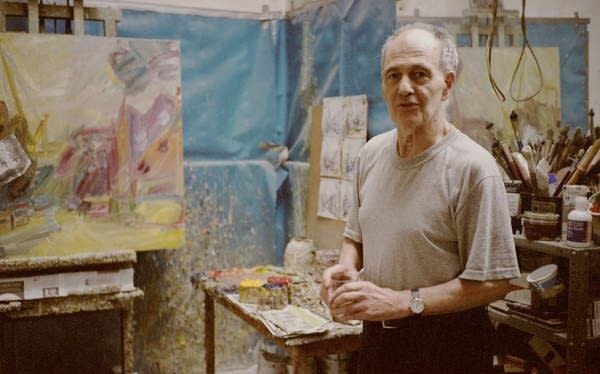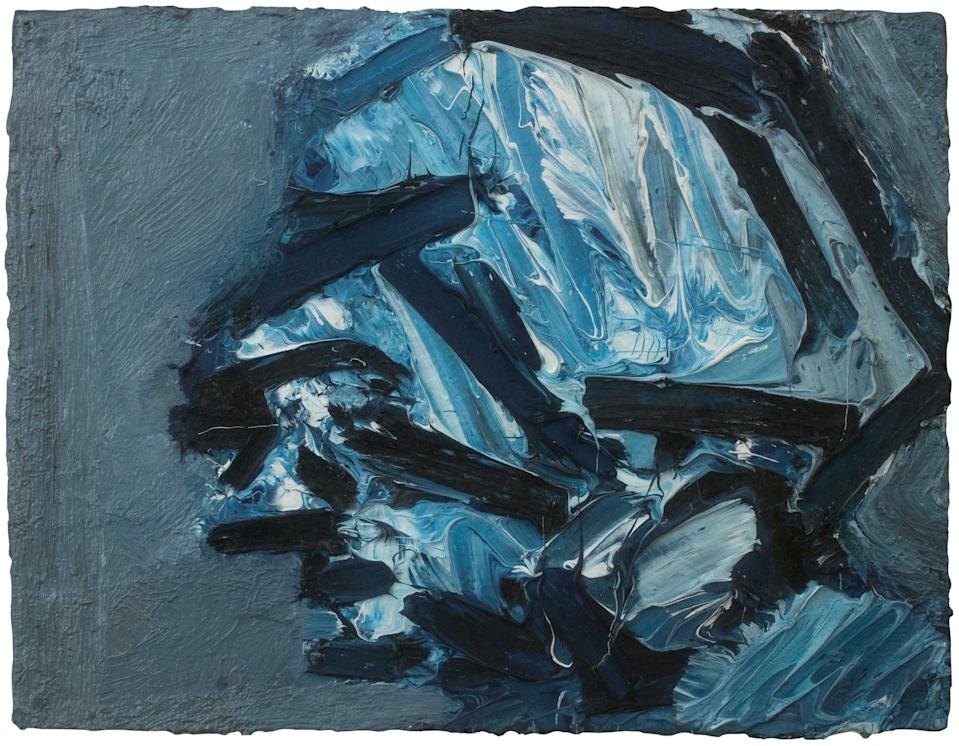‘Admiring oneself is such a waste of energy’: British art’s great survivor Frank Auerbach
- Oops!Something went wrong.Please try again later.

“Hello,” says a gentle, friendly voice, with the faintest of German accents. “This is Frank Auerbach.” I can’t see the 91-year-old British artist, arguably this country’s most important living painter. Face-to-face interviews are too energy-zapping, he explains, and he doesn’t do Zoom: “I haven’t got the internet; I’m not in the 21st century at all.” But I can hear him as he genially reminisces, crackling down the landline like a wireless broadcast from another era. “I always gabble,” he warns me, before talking lucidly for an hour, in pristine paragraphs.
For someone who once fobbed off a documentary filmmaker by saying, “I am the beast in the burrow who does not wish to be invaded”, Auerbach – still sheltering in the same 20ft-sq studio behind Mornington Crescent in north London, where he has worked (and often slept) almost every day since 1954 – is surprisingly witty and warm. Erudite, too. A delightful, civilised creature, then, not a misanthropic monster. His “buoyant” spirit, he says, “may be defeated eventually. But I still seem to carry on.”
Notoriously, Auerbach used to maintain a routine so rigorous it would make the most devout anchorite blanche: up every day before 7am to make drawings in the streets of Camden Town, before retiring to the studio – previously occupied by his artist friend Leon Kossoff – to paint. No time off, no holidays, not even a break for Christmas. Surely, this severe regimen has now eased off?
“Oh, it has,” he tells me. “I haven’t got the energy I used to.” During the Fifties and Sixties, he ventured across London, to Smithfield market, Hungerford Bridge, Leicester Square – all of which have appeared in his energetic streetscapes. Not anymore: “As I got older and more tired, I’ve been nearer and nearer to my front door.”
His weekly schedule, which, he agrees, was “absolutely relentless”, also involved around “six sittings with people at regular times”. A new exhibition at the Piano Nobile gallery in west London – the first big Auerbach show in Britain since his 2015 Tate retrospective – brings together more than 40 of his portrait paintings and drawings, made between 1956 and 2020.

The sittings stopped, though, during the pandemic, when the only person he could paint was his sick wife, Julia, with whom he has a son, Jake, a filmmaker. So, he says, “I started doing self-portraits” – a genre that, as a younger man, he’d considered “banal”. “I didn’t think I was interesting,” he explains, “unlike [Albrecht] Dürer and [Gustave] Courbet, who I suspect were both their mothers’ favourite sons, and painted themselves with admiration.”
Vanity isn’t something Auerbach does: “There’s no point in looking back and admiring oneself. It’s such a waste of energy.” Why is he so hard on himself? He laughs wryly. “Because I’ve got decent critical standards.” Compared with Picasso – “who may be,” he says, “the greatest painter who ever lived” – “who doesn’t feel a midget?”
Despite this, he still finds painting “very, very amusing”. The art critic William Feaver, one of Auerbach’s regular sitters, and the author of a newly revised monograph, published this month (which reproduces his recent series of self-portraits, with their flickering, disintegrating graphite marks), has divined a new strain running through his pictures: a zig-zagging “zest”, which, Feaver believes, is “more a matter of letting go”.
Does Auerbach recognise what art historians would call his “late style”? “I have noticed a development,” he tells me, “but it’s entirely involuntary: there’s something slightly less willed and strenuous about the look of things. I don’t say they’re better, but possibly more fluent and organic.”
Could this be stimulated, as Feaver implies, by a sense of imminent death? A prominent death’s head appears in another recent series featuring a corner of his studio; the same phantasm pops up again in two views from his door, both titled Way Out. “Well,” he replies, “possibly because of my background, I’ve always painted as though I’m going to die tomorrow.”

Born in Berlin in 1931 (his father, from a distinguished line of rabbis, was a patent lawyer; his mother had studied art), Auerbach was sent, to evade the Nazis, to Bunce Court, a boarding school surrounded by bluebell woods in Kent, “just before my eighth birthday”. “Then the war started,” he recalls. “And I never saw again a single person that I’d seen before.”
The last postcard he received from his parents arrived in 1942; he subsequently learned that they were killed, probably in Auschwitz. But, he says, “I’d be grateful if you didn’t make too much of it, because it seems to me to be maudlin and unnecessary. Psychiatrists accuse people of being in denial. I find being in denial has worked for me all my life.” When Auerbach received a parcel after the war containing his father’s gold watch, he sold it. “I’ve just forged on,” he says, “and hoped for the best.”
At 16, he arrived in London, which, he says, “was not very far off what pictures of Ukraine look like now. There were bombsites on every street, holes in the ground, shattered buildings. I was very conscious of living in a ruined city.”
Yet, he recalls, “the spirit of Londoners was extraordinary: stoical and admirable. We seemed to keep going on cups of strong tea, Woodbines, and baked beans, with a remarkably uncomplaining spirit. In a sense, we’d been equalised by the war, and by the fact that we’d all survived it.”
Despite the devastation and deprivation, then, does he look back fondly on those post-war years? “I do,” Auerbach replies. “And, of course, I was young. It all seemed an adventure.”

To begin with, Auerbach tried his hand at acting. While, though, “I kid myself that if I had persisted, I might have become a proper actor,” his efforts were, he says, “very superficial – and it wasn’t long before all my energies went into trying to paint.” In 1952, having already trained under David Bomberg and studied at St Martin’s, he started at the Royal College of Art, alongside Bridget Riley and Peter Blake.
In those days, Auerbach recalls, “it was assumed that one would have an endless struggle in one’s life: I was told there were no more than 50 people in England making a living by painting.” Yet, “by the time that [David] Hockney and [RB] Kitaj came to the college, only about five years after me, the spirit had changed – and there was a feeling that people could communicate with the public, and live by the brush.”
Hockney found success quickly – but, Auerbach says, “I was never envious of anybody.” Today, he even thinks of Hockney “as head of the profession, in a sense. I think we’re jolly lucky to have him: somebody as prolific and active and questioning appears very rarely in English art.”
The show at Piano Nobile explores Auerbach’s obsession with depicting the human head, which began, he tells me, in the early Fifties, when “I started painting one person I was very closely involved with”: Estella West, a widow (and mother of three children) in her thirties, whom he’d met a few years earlier while acting in a production in which she also had a role. For a while, Auerbach lodged in the basement of her house in Earl’s Court; the affair they began lasted 25 years. West, says Auerbach, “was good enough to sit for me three nights a week, and I found it was more interesting to do than to paint anything I cared about less.” (In his titles, she is always identified by her initials, “E.O.W.”) At the time, he was also “aware”, he says, “that empathetic images of the human head had disappeared from current painting. And I wanted to fill that gap.”

The different ways he went about this still look radical, surprising. At Piano Nobile, for instance, several early, eerie monumental charcoal drawings, the paper abraded and even patched where Auerbach ferociously scrubbed at it with an eraser, depict theatrically lit women with extra-terrestrially swollen heads. In a 1965 oil-on-board head of his older cousin Gerda Boehm, once owned by David Bowie, the paint is mouth-wateringly thick: a slip-sliding cream-cake of meringue-stiff peaks and icing-like swirls.
Sometimes, Auerbach gouges his sitters’ eyes from the impasto as one might carve a pumpkin at Halloween. A head from 1967 looks more like an electronic circuit board than a human being, with squiggly, worm-like components that could have been squeezed from a tube of colourful toothpaste. The three-dimensionality of Auerbach’s pictures is important: at one point, he talks about trying to convey a sense of “mass” in his work rather than simply “surface pattern”. In his portraits, it’s often said, he wasn’t after a likeness but a presence.
During the Fifties, Auerbach also met his lifelong friend Lucian Freud, another Jewish artist born in Berlin who spent most of his life in Britain. Does he miss Freud, who died in 2011? “Certainly,” Auerbach says, “because, as far as I was concerned, he was one of the nicest people I knew: loyal, straightforward, interesting, funny, amusing, generous – a very good friend.” He chuckles. “When Lucian first saw my work, he thought it was the most amazingly god-awful mess. And when I first saw his early paintings, which were done with a sable brush, with that very intense, literal quality, their idiom seemed to me banal.”

As time went on, though, “I began to realise, when I was not quite such an idiot, that intensity and range and courage mattered more than idiom.”
Freud sometimes invited Auerbach over to his studio, usually at 6am, to offer opinions on his latest canvases. Did Auerbach ever seek Freud’s advice? “Our way of working was very different,” he replies. “I repaint my pictures every day, from top to bottom.” Typically dissatisfied with what he has produced, he scrapes off all the paint at the end of a session, before, next time, starting again; some portraits require a hundred or more sittings. “If something looks like a picture,” he tells me, “it’s not art.”
How does he know, then, when something is finished? “When it seems to cohere, to be fresh, to be unfamiliar – and when it seems to be true to the subject.” He pauses. “I’ve very rarely abandoned things: I’ve got a sort of dogged, or perhaps unadventurous, nature that makes me go on with everything I’m working on.”
At the same time, he says, “I’ve got no faith in my ability to turn out pictures.” Seriously? “I’ve been working for 70 years, but, every time I pick up a brush, I am totally incompetent, and I start again from the beginning.”
So, why does he persist? “Because there’s hope – the hope of finishing something, like finding an Easter egg,” he says. Painting, he explains, is “unpredictable”. But it’s also “a marvellous game, with, at the end of it, a sensational revelation.”
Frank Auerbach: The Sitters is at Piano Nobile, London W11 until December 16; piano-nobile.com
Frank Auerbach by William Feaver (Rizzoli, £55) is out now

